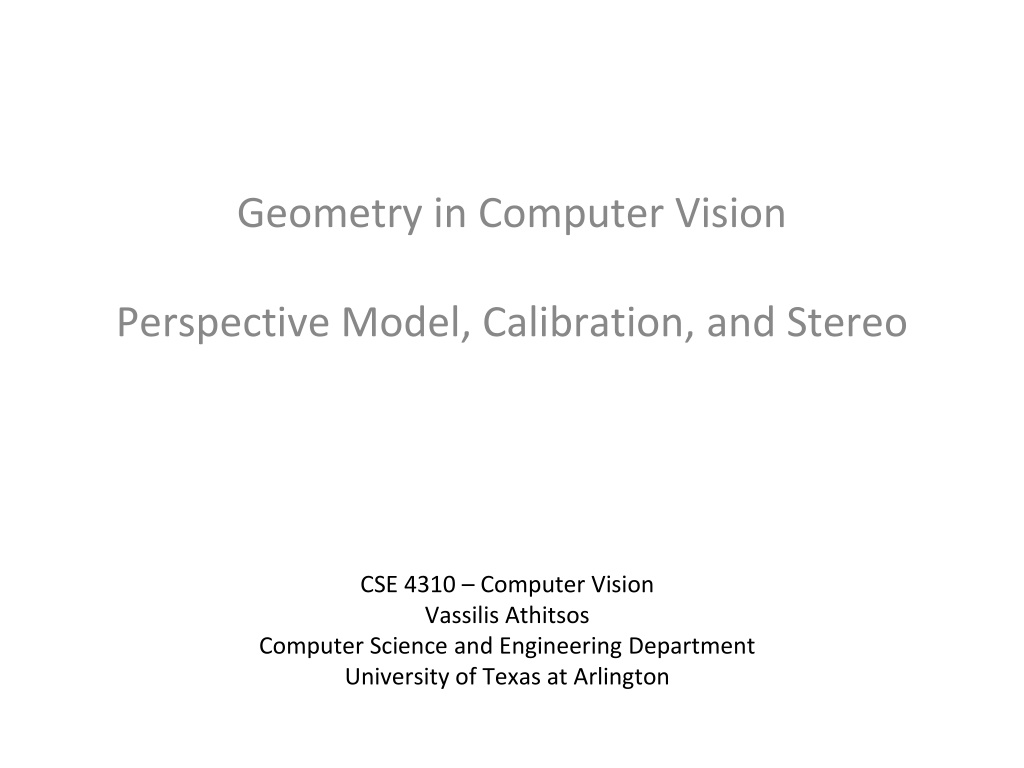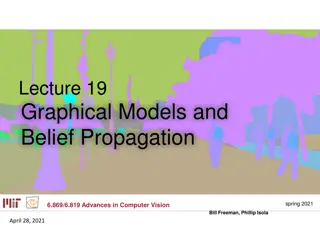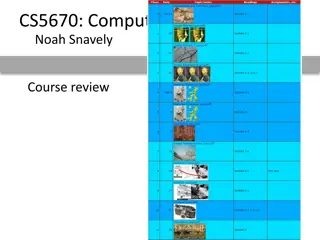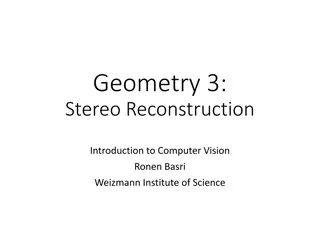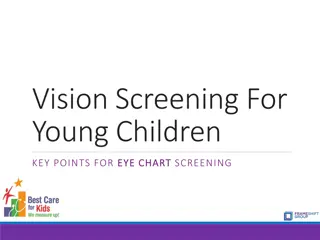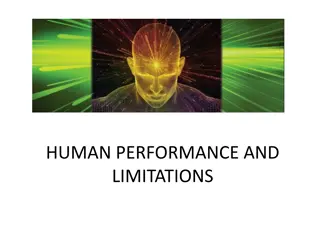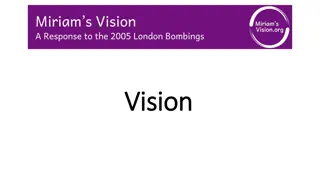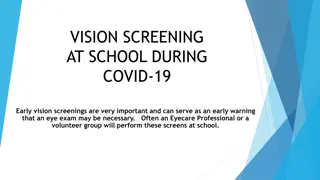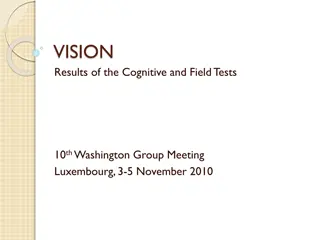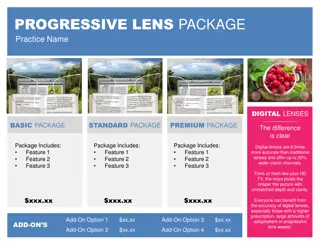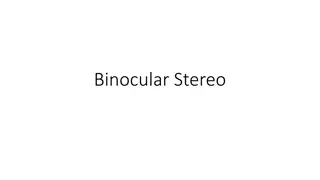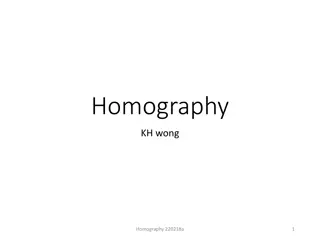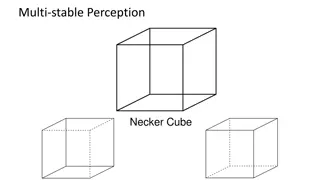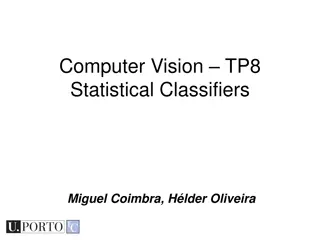Understanding 3D Information in Computer Vision
Exploring the importance of estimating 3D information in computer vision applications, such as perspective camera models, stereo vision, and the transition from 2D to 3D representations. It discusses the need for detailed 3D data for tasks like object manipulation, obstacle detection for unmanned vehicles, and interpreting human gestures. The concept of collinearity in pinhole camera models is also introduced.
Download Presentation

Please find below an Image/Link to download the presentation.
The content on the website is provided AS IS for your information and personal use only. It may not be sold, licensed, or shared on other websites without obtaining consent from the author. Download presentation by click this link. If you encounter any issues during the download, it is possible that the publisher has removed the file from their server.
E N D
Presentation Transcript
Geometry in Computer Vision Perspective Model, Calibration, and Stereo CSE 4310 Computer Vision Vassilis Athitsos Computer Science and Engineering Department University of Texas at Arlington
Part 1 Perspective Camera Model 2
3D information Ideally (but rarely in practice), we would like to know for every pixel: How far the location depicted in that pixel is from the camera. What other types of 3D information would we want to know about objects and surfaces visible in the image? 3
3D information Ideally (but rarely in practice), we would like to know for every pixel: How far the location depicted in that pixel is from the camera. For the objects and surfaces that are visible in the image, we would like to know: what their 3D shape is. where they are located in 3D. how big they are. how far they are from the camera and from each other. 4
The Need for 3D Information What kind of applications would benefit from estimating 3D information? 5
The Need for 3D Information What kind of applications would benefit from estimating 3D information? A robot that wants to grasp an object must know how far its hand is from the object. An unmanned vehicle needs to know how far obstacles are, in order to determine if it is safe to continue moving or not. 3D information can tell us, for a person viewed from the side, whether the left leg or the right leg is at the front. 3D information can help determine the object where someone is pointing. 6
From 2D to 3D and Vice Versa To estimate 3D information, we ask the question: Given a pixel (u, v), what 3D point (x, y, z) is seen at that pixel? That is a hard problem (one-to-many). Can be solved if we have additional constraints. For example, if we have two cameras (stereo vision). We start by solving the inverse problem, which is easier: Given a 3D point (x, y, z), what pixel (u, v) does that 3D point map to? This can be easily solved, as long as we know some camera parameters. 7
Pinhole Model y axis P(A) B z axis pinhole focal length f P(B) A image plane Terminology: image plane is a planar surface of sensors. The response of those sensors to light is the signal that forms the image. The focal length f is the distance between the image plane and the pinhole. A set of points is collinear if there exists a straight line going through all points in the set. 8
Pinhole Model y axis P(A) B z axis pinhole focal length f P(B) A image plane Pinhole model: light from all points enters the camera through an infinitesimal hole, and then reaches the image plane. The focal length f is the distance between the image plane and the pinhole. the light from point A reaches image location P(A), such that A, the pinhole, and P(A) are collinear. 9
Different Coordinate Systems y axis P(A) B z axis pinhole focal length f P(B) A image plane World coordinate system (3D): Pinhole is at location t, and at orientation R. Camera coordinate system (3D): Pinhole is at the origin. The camera faces towards the positive side of the z axis. 10
Different Coordinate Systems y axis P(A) B z axis pinhole focal length f P(B) A image plane Normalized image coordinate system (2D): Coordinates on the image plane. The (x, y) values of the camera coordinate system. We drop the z value (always equal to f, not of interest). Center of image is (0, 0). Image (pixel) coordinate system (2D): pixel coordinates. 11
Pinhole Model y axis P(A) B z axis pinhole focal length f P(B) A image plane A simple example: Assume that world coordinates = camera coordinates. Assume that the z axis points right, the y axis points up. The x axis points away from us. If A is at position (Ax, Ay, Az), what is P(A)? Note: A is in world coordinates, P(A) is in normalized image coordinates. 12
Pinhole Model y axis P(A) B z axis pinhole focal length f P(B) A image plane P(A) = (-Ax/Az * f, -Ay/Az * f). P(A) is two-dimensional (normalized image coordinates). This is a simple formula, because we chose a convenient coordinate system (world coordinates = camera coordinates). What happens if the pinhole is at (Cx, Cy, Cz)? 13
Handling Camera Translation y axis P(A) B z axis pinhole focal length f P(B) A image plane If the pinhole is at (Cx, Cy, Cz)? We define a change-of-coordinates transformation T. In new coordinates, the hole is at T(Cx, Cy, Cz) = (0, 0, 0). If V is a point, T(V) = V - (Cx, Cy, Cz). T(A) = T(Ax, Ay, Az) = (Ax Cx, Ay Cy, Az Cz) P(A) = (-(Ax-Cx)/(Az-Cz) * f, -(Ay-Cy)/(Az-Cz) * f). Remember, P(A) is in normalized image coordinates. 14
Handling Camera Translation y axis P(A) B z axis pinhole focal length f P(B) A image plane If the pinhole is at (Cx, Cy, Cz): P(A) = (-(Ax-Cx)/(Az-Cz) * f, -(Ay-Cy)/(Az-Cz) * f). The concept is simple, but the formulas are messy. Formulas get a lot more messy in order to describe arbitrary camera placements. We also need to allow for rotations. We simplify notation using homogeneous coordinates. 15
Homogeneous Coordinates Homogeneous coordinates are used to simplify formulas, so that camera projection can be modeled as matrix multiplication. For a 3D point: instead of writing we write where c can be any constant. How many ways are there to write in homogeneous coordinates? INFINITE (one for each real number c). For a 2D point : we write it as . v cx cy cz c x y z x y z cu cv c u 16
Revisiting Simple Case y axis P(A) B z axis pinhole focal length f P(B) A image plane World coordinates = camera coordinates. Ax Ay (-Ax/Az) * f (-Ay/Az) * f 1 Let A= , P(A) = . Then: Az 1 How do we write P(A) as a matrix multiplication? 17
Revisiting Simple Case y axis P(A) B z axis pinhole focal length f P(B) A image plane World coordinates = camera coordinates. Ax Ay (-Ax/Az) * f (-Ay/Az) * f 1 Let A= , P(A) = . Then: Az 1 Ax Ay Az 1 Ax Ay Az 1 (-Ax/Az) * f (-Ay/Az) * f 1 1 0 0 0 0 1 0 0 0 0 -1/f 0 Ax Ay -Az/f (-Ax/Az) * f (-Ay/Az) * f 1 1 0 0 0 0 1 0 0 0 0 -1/f 0 Why? = = = 18
Revisiting Simple Case y axis P(A) B z axis pinhole focal length f P(B) A image plane World coordinates = camera coordinates. Ax Ay Az 1 (-Ax/Az) * f (-Ay/Az) * f 1 1 0 0 0 0 1 0 0 0 0 -1/f 0 Let A= . P(A) = . Define C1 = . Then: P(A) = C1 * A. We map world coordinates to normalized camera coordinates using a simple matrix multiplication. 19
Handling Camera Translation y axis P(A) B z axis pinhole focal length f P(B) A image plane Suppose camera is at (Cx, Cy, Cz). Camera coordinates and world coordinates are different. Define T(A) to be the transformation from world coordinates to camera coordinates. If we know T(A), what is P(A)? 20
Handling Camera Translation y axis P(A) B z axis pinhole focal length f P(B) A image plane Suppose camera is at (Cx, Cy, Cz). Camera coordinates and world coordinates are different. Define T(A) to be the transformation from world coordinates to camera coordinates. If we know T(A), what is P(A)? P(A) = C1 * T(A). 21
Handling Camera Translation y axis P(A) B z axis pinhole focal length f P(B) A image plane Suppose camera is at (Cx, Cy, Cz). Define T(A) to be the transformation from world coordinates to camera coordinates. If we know T(A), P(A) = C1 * T(A). How can we write T(A) as a matrix multiplication? 22
Handling Camera Translation y axis P(A) B z axis pinhole focal length f P(B) A image plane First of all, how can we write T(A) in the most simple form, in non-homogeneous coordinates? (Forget about matrix multiplication for a second). 23
Handling Camera Translation y axis P(A) B z axis pinhole focal length f P(B) A image plane First of all, how can we write T(A) in the most simple form, in non-homogeneous coordinates? T(A) = (Ax, Ay, Az) (Cx, Cy, Cz). How can we represent that as a matrix multiplication? 24
Handling Camera Translation y axis P(A) B z axis pinhole focal length f P(B) A image plane T(A) = (Ax, Ay, Az) (Cx, Cy, Cz). Ax Cx Ay Cy Az Cz 1 1 0 0 -Cx 0 1 0 -Cy 0 0 1 -Cz 0 0 0 1 Ax Ay Az 1 In homogeneous coordinates: = Homogeneous coordinates allow us to represent translation as matrix multiplication. 25
Handling Camera Translation y axis P(A) B z axis pinhole focal length f P(B) A image plane 1 0 0 -Cx 0 1 0 -Cy 0 0 1 -Cz 0 0 0 1 Ax Ay 1 0 0 0 0 1 0 0 0 0 -1/f 0 Let A= . Define C1 = , T = Az 1 Then: P(A) = C1 * T * A. P(A) is still a matrix multiplication: We multiply A by (C1 * T). 26
Handling Camera Translation y axis P(A) B z axis pinhole focal length f P(B) A image plane 1 0 0 -Cx 0 1 0 -Cy 0 0 1 -Cz 0 0 0 1 Ax Ay 1 0 0 0 0 1 0 0 0 0 -1/f 0 Let A= . Define C1 = , T = Az 1 Then: P(A) = C1 * T * A. Why is C1 of size 3x4 and T of size 4x4? 27
Handling Camera Translation y axis P(A) B z axis pinhole focal length f P(B) A image plane 1 0 0 -Cx 0 1 0 -Cy 0 0 1 -Cz 0 0 0 1 Ax Ay 1 0 0 0 0 1 0 0 0 0 -1/f 0 Let A= . Define C1 = , T = . Az 1 Then: P(A) = C1 * T * A. Why is C1 3x4 and T 4x4? T maps 3D coordinates to 3D coordinates. C1 maps 3D coordinates to normalized image (2D) coordinates. 28
Handling Camera Rotation y axis P(A) B z axis pinhole focal length f P(B) A image plane The camera can be rotated around the x axis, around the y axis, and/or around the z axis. Rotation transformation R: rotates the world coordinates, so that the x, y, and z axis of the world coordinate system match the x, y, and z axis of the camera coordinate system. 29
Handling Camera Rotation In non-homogeneous coordinates, rotation of A around the origin can be represented as R*A. R: 3x3 rotation matrix. How does camera rotation affect the image? 30
Handling Camera Rotation In non-homogeneous coordinates, rotation of A around the origin can be represented as R*A. R: 3x3 rotation matrix. How does camera rotation affect the image? It changes the viewing direction. Determines what is visible. It changes the image orientation. Determines what the up direction in the image corresponds to in the 3D world. Rotating the camera by Rc has the same affect as rotating the world by the inverse of Rc. That is, rotating every point in the world, around the origin, the opposite way of what is specified in Rc. 31
Handling Camera Rotation Any rotation R can be decomposed into three rotations: a rotation Rxby x around the x axis. a rotation Ryby y around the y axis. a rotation Rzby z around the z axis. Rotation of point A = R * A = Rz * Ry * Rx * A. ORDER MATTERS. Rz * Ry * Rx * A is not the same as Rx * Ry * Rz * A. 1 0 0 0 cos x -sin x 0 sin xcos x Rx cos y0 sin y 0 1 0 -sin y0 cos y Ry cos z -sin z 0 sin zcos z 0 0 0 1 Rz 32
Handling Camera Rotation y axis P(A) B z axis pinhole focal length f P(B) A image plane In homogeneous coordinates, rotation of A around the origin can be represented as R*A. R: 4x4 rotation matrix. r11 r12 r13 0 r21 r22 r23 0 r31 r32 r33 0 0 0 0 1 r11 r12 r13 r21 r22 r23 Let R = . Then, R = . r31 r32 r33 33
Handling Camera Rotation y axis P(A) B z axis pinhole focal length f P(B) A image plane r11 r12 r13 0 r21 r22 r23 0 r31 r32 r33 0 0 0 0 1 r11 r12 r13 r21 r22 r23 r31 r32 r33 Let R = . Then, R = . What is the right way to write P(A) so that we include translation and rotation? 34
Handling Camera Rotation y axis P(A) B z axis pinhole focal length f P(B) A image plane r11 r12 r13 0 r21 r22 r23 0 r31 r32 r33 0 0 0 0 1 r11 r12 r13 r21 r22 r23 Let R = . Then, R = . r31 r32 r33 What is the right way to write P(A) so that we include translation and rotation? Would it be P(A) = C1 * T * R *A? 35
Handling Camera Rotation y axis P(A) B z axis pinhole focal length f P(B) A image plane r11 r12 r13 0 r21 r22 r23 0 r31 r32 r33 0 0 0 0 1 r11 r12 r13 r21 r22 r23 Let R = . Then, R = . r31 r32 r33 Is it true that P(A) = C1 * T * R *A? NO, we must first translate and then rotate. Why? 36
Handling Camera Rotation y axis P(A) B z axis pinhole focal length f P(B) A image plane r11 r12 r13 0 r21 r22 r23 0 r31 r32 r33 0 0 0 0 1 r11 r12 r13 r21 r22 r23 Let R = . Then, R = . r31 r32 r33 Is it true that P(A) = C1 * T * R *A? NO, we must first translate and then rotate. Rotation is always around the origin. First we must apply T to move the pinhole to the origin, and then we can apply R. 37
Handling Camera Rotation y axis P(A) B z axis pinhole focal length f P(B) A image plane r11 r12 r13 0 r21 r22 r23 0 r31 r32 r33 0 0 0 0 1 r11 r12 r13 r21 r22 r23 Let R = . Then, R = . r31 r32 r33 P(A) = C1 * R * T * A. P(A) is still modeled as matrix multiplication. We multiply A with matrix (C1 * R * T). 38
Handling Scale y axis P(A) B z axis pinhole focal length f P(B) A image plane r11 r12 r13 0 r21 r22 r23 0 r31 r32 r33 0 0 0 0 1 1 0 0 -Cx 0 1 0 -Cy Ax Ay 1 0 0 0 0 1 0 0 0 0 -1/f 0 Let A= , C1 = , R = Az 1 , T = . 0 0 1 -Cz 0 0 0 1 P(A) = C1 * R * T * A accounts for translation and rotation. Translation: moving the camera. Rotation: rotating the camera. Scaling: what does it correspond to? 39
Handling Scale y axis P(A) B z axis pinhole focal length f P(B) A image plane r11 r12 r13 0 r21 r22 r23 0 r31 r32 r33 0 0 0 0 1 1 0 0 -Cx 0 1 0 -Cy Ax Ay 1 0 0 0 0 1 0 0 0 0 -1/f 0 Let A= , C1 = , R = Az 1 , T = . 0 0 1 -Cz 0 0 0 1 P(A) = C1 * R * T * A accounts for translation and rotation. Translation: moving the camera. Rotation: rotating the camera. Scaling: corresponds to zooming (changing focal length). 40
Handling Scale y axis P(A) B z axis pinhole focal length f P(B) A image plane r11 r12 r13 0 r21 r22 r23 0 r31 r32 r33 0 0 0 0 1 1 0 0 -Cx 0 1 0 -Cy Ax Ay 1 0 0 0 0 1 0 0 0 0 -1/f 0 Let A= , C1 = , R = Az 1 , T = . 0 0 1 -Cz 0 0 0 1 P(A) = C1 * R * T * A accounts for translation and rotation. Translation: moving the camera. Rotation: rotating the camera. How do we model scaling? 41
Handling Scale y axis P(A) B z axis pinhole focal length f P(B) A image plane r11 r12 r13 0 r21 r22 r23 0 r31 r32 r33 0 0 0 0 1 1 0 0 -Cx 0 1 0 -Cy Ax Ay 1 0 0 0 0 1 0 0 0 0 -1/f 0 Let A= , C1 = , R = Az 1 , T = . 0 0 1 -Cz 0 0 0 1 P(A) = C1 * R * T * A accounts for translation and rotation. How do we model scaling? Scaling is already handled by parameter f in matrix C1. If we change the focal length we must update f. 42
World to Normalized Image Coords y axis P(A) B z axis pinhole focal length f P(B) A image plane r11 r12 r13 0 r21 r22 r23 0 r31 r32 r33 0 0 0 0 1 1 0 0 -Cx 0 1 0 -Cy Ax Ay 1 0 0 0 0 1 0 0 0 0 -1/f 0 Let A= , C1 = , R = Az 1 , T = . 0 0 1 -Cz 0 0 0 1 P(A) = C1 * R * T * A maps world coordinates to normalized image coordinates Equation holds for any camera following the pinhole camera model. 43
Computing Pixel Coordinates The normalized image coordinate system does not produce pixel coordinates. Example: the center of the image is at (0, 0). What is needed to map normalized image coordinates to pixel coordinates? Translation? Scaling? Rotation? 44
Computing Pixel Coordinates The normalized image coordinate system does not produce pixel coordinates. Example: the center of the image is at (0, 0). What is needed to map normalized image coordinates to pixel coordinates? Translation? Yes, we must move center of image to (image_columns/2, image_rows/2). Scaling? Rotation? 45
Computing Pixel Coordinates The normalized image coordinate system does not produce pixel coordinates. Example: the center of the image is at (0, 0). What is needed to map normalized image coordinates to pixel coordinates? Translation? Yes, we must move center of image to (image_columns/2, image_rows/2). Scaling? Yes, according to pixel size (how much area of the image plane does a pixel correspond to?). In the general case, two constants, Sx and Sy, if the pixel corresponds to a non-square rectangle on the image plane. In the typical case, Sx = Sy. Rotation? 46
Computing Pixel Coordinates The normalized image coordinate system does not produce pixel coordinates. Example: the center of the image is at (0, 0). What is needed to map normalized image coordinates to pixel coordinates? Translation? Yes, we must move center of image to (image_columns/2, image_rows/2). Scaling? Yes, according to pixel size. In the general case, two constants, Sx and Sy, if the pixel corresponds to a non-square rectangle on the image plane. In the typical case, Sx = Sy. Rotation? NO. The x and y axes of the two systems match. 47
Homography The matrix mapping normalized image coordinates to pixel coordinates is called a homography. A homography matrix H looks like this: Sx 0 u0 0 Sy v0 0 0 1 H = where: Sx and Sy define scaling (typically Sx = Sy). u0 and v0 translate the image so that its center moves from (0, 0) to (u0, v0). 48
Putting It All Together Ax Ay Az 1 Let A= . What pixel coordinates (u, v) will A be mapped to? r11 r12 r13 0 r21 r22 r23 0 r31 r32 r33 0 1 0 0 -Cx 0 1 0 -Cy 0 0 1 -Cz 0 0 0 1 1 0 0 0 0 1 0 0 Sx 0 u0 0 Sy v0 0 0 1 C1 = , R = , T = , H = . 0 0 -1/f 0 0 0 0 1 49
Putting It All Together Ax Ay Az 1 Let A= . What pixel coordinates (u, v) will A be mapped to? r11 r12 r13 0 r21 r22 r23 0 r31 r32 r33 0 1 0 0 -Cx 0 1 0 -Cy 0 0 1 -Cz 0 0 0 1 1 0 0 0 0 1 0 0 Sx 0 u0 0 Sy v0 0 0 1 C1 = , R = , T = , H = . 0 0 -1/f 0 0 0 0 1 u v = H * C1 * R * T * A. w u = u /w , v = v /w . 50
